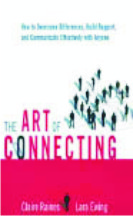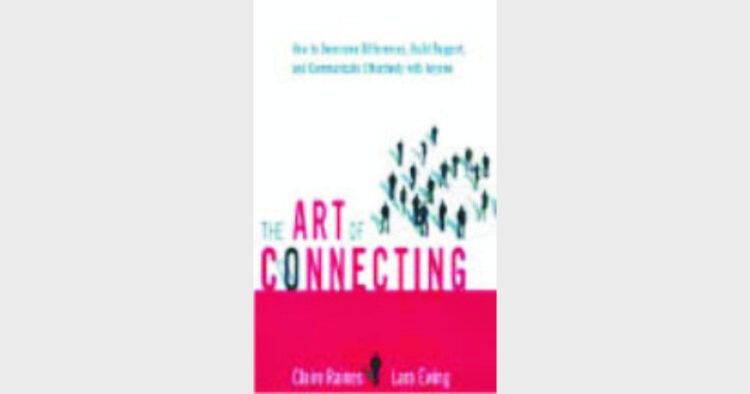Nidhi Mathur?
 The Art of Connecting: How to Overcome Differences, Build Rapport and Communicate Effectively with Anyone, Claire Raines and Lara Ewing, BPI India Pvt Ltd, Pp 230?
The Art of Connecting: How to Overcome Differences, Build Rapport and Communicate Effectively with Anyone, Claire Raines and Lara Ewing, BPI India Pvt Ltd, Pp 230?
As the global marketplace and e-business create greater intersection across cultures, time zones, races and religions, each of us is getting forced to connect thorough differences. Business results – sale, the profitability of a small business, the success of an article – depend on the ability to communicate effectively across cultures.
The book shows how to become more adept at forging these essential connections. If you want to bridge the gap that separates people from different background – whether it’s ethnic, perceptual, generational, gender or cultural in nature – the book provides a strategy for it.
The two authors of the book approached a hundred people in a variety of industries and chose four people out of whom one was a couple and all are masters at connecting. They studied the way these four interacted with a wide variety of people and learned about the principles that guided them. By observing their interactions, the authors isolated a set of steps used to forge connections.
The book profiles the four masters of connection and introduces the Titanium Rule – Do unto others according to their druthers. All the four individuals held a common set of principles and these were:
* There is always a bridge, that is, find a common ground with all people, no matter how different they are from others
* Curiosity is the key. Being most inquisitive people, these four masters are fascinated by people, especially those who come from different backgrounds. Curiosity opens a mental door
* What you assume is what you get. The masters approach each person they meet, no matter how they differ, expecting the best. They get into every interaction with anticipation and eagerness. They presume this is a good person who has valuable contributions to make and important things to say
* Each individual is a culture – Here the masters are curious about the other’s family, beliefs, education, key events in his life, personal style, artistic tastes, what kind of movies he likes, etc.
* No strings attached. The masters don’t expect reciprocity.
The masters do their best to learn what caused the reaction they have received, so they can be more successful in the future.
The book gives directions for facilitating team-building activities that help people close the diversity gap.
The authors are sure that eventually the strategies and skills will become a part of your dealings with other people.
(BPI India Pvt Ltd, F-213/A Ground floor, Old Mehrauli-Badarpur Road, Lado Sarai, New Delhi-1100030; sales@bpiindia.com).
A short, pithy story?
Nidhi Mathur?
 The Journey of a Burning Boat, Abdus Samad, Promilla & Co Publishers, Pp 178, Rs 250.00
The Journey of a Burning Boat, Abdus Samad, Promilla & Co Publishers, Pp 178, Rs 250.00
In this short but very pithily told story about Sheila, who, though nearing some two score years, with her highly made-up face attracts people like bees to a honeycomb. Notoriety and popularity seem her innate mystic persona, giving her an unusual eminence in the village. She has no other relative, close or distant, except her father, who is a teacher in a primary school. It is rumoured that she resides in a hostel not well looked upon. It is also said she jostles with shady characters. Heaven knows what the truth is but her appearance – bedecked with jewellery make people wonder if she is really the daughter of Tikaram, the teacher. The villagers gossip about her through tight lips and Sheila takes the fullest advantage of their disapproving non-interference. Whenever she visits the village, she leaves a blazing trail like a comet. She visits all and sundry without reservation.
No matter what the villagers say about her, she is, however, the only hope of the young unwed girls of the village from which every year one or two girls are known to vanish. No one knows where the girls go, but after some time money orders are received from them by the parents, who presume their daughters are doing well, else they would have hung like albatrosses round their parent’s neck.
One day a young girl called Chanda from this village, with a letter from Sheila Didi, visits the latter’s castle-like house in the town. She is taken in and made comfortable. Sheila instructs a woman to take Chanda for shopping and to get her done up in a beauty parlour.
Chanda goes to sleep but without forgetting her parents. She realises that even if they were to forget her, she hopes to make them happy one day and is driven to do what she is doing for their sake.
The story describes her experiences and how she is ridiculed by older men who are her customers. Not only that, it takes the reader into the depths of Indian society – to the towns, cities and countryside where impoverished children without hope are lured and trapped in the flesh trade that is practiced with subtle élan.
(Promilla & Co Publishers, C-127, Sarvodaya Enclave, New Delhi-110 017; www.biblioasia.com)?













Comments